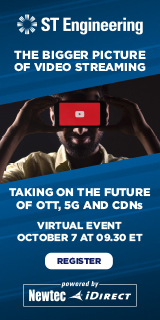Interview with Hans Massart, Head of Media and Broadcast, ST Engineering iDirect
 Sint-Niklaas, Belgium, September 8, 2020--To shed light on the role that satellites can play in an world increasingly dominated by Over-the-Top services, Satelltie Executive Briefing spoke with Hans Massart, Head of Media and Broadcast, ST Engineering iDirect. Excerpts of the interview follows:
Sint-Niklaas, Belgium, September 8, 2020--To shed light on the role that satellites can play in an world increasingly dominated by Over-the-Top services, Satelltie Executive Briefing spoke with Hans Massart, Head of Media and Broadcast, ST Engineering iDirect. Excerpts of the interview follows:
How has the recent merger of ST Engineering iDirect and Newtec strengthened your position in the broadcast markets?
The merger has brought together two companies with their own strengths. Newtec has always had a strong presence in the broadcast market and iDirect has a strong foothold in convergence and innovation. The merger allows us to leverage and combine into strengthening the focus, widening it beyond traditional broadcast with an importance across all the vertical markets that we serve.
By bringing the two companies together, we have widened both our portfolio and our reach. The combination means that we now have much more resources open to us and more representation across the world so that our customers benefit on a local level. We have a great team of people that can support our work in the broadcast sector and enable us to do more. Looking to the future and the use of VSAT platforms for broadcast purposes such as All-IP for contribution and distribution, or OTT video delivery in general, we now suddenly have a very large installed base of both iDirect legacy VSAT systems on top of the Newtec systems already out there. We are looking forward to building on our very strong market position and continuing the innovation that the broadcast sector recognizes us for.
How is ST Engineering iDirect continuing to innovate in the broadcast market?
We keep on pioneering. There are many innovations we propose for the broadcast market, especially in terms of the move to IP. We are constantly asking ourselves how we can more efficiently and effectively transport OTT signals over satellite. We are contributing, as we have always done, to designing new standards with DVB. We are also participating in different forums on distribution of video over 5G networks and investigating how we move forward to build a successful 5G ecosystem and facilitate efficient video transportation over such networks.
It’s not just the broadcast market, though. We are looking into how video is being used in so much of what we do on a daily basis. We are very aware that video is used across many different verticals such as enterprise, IFC, mobility, government, etc. It’s not necessarily just the broadcast market that utilizes video – it’s a plethora of markets, and we need to find the best way to deliver to these users as well.
As most of the world faces the impact of the COVID-19 pandemic and beyond, what do you see as the key trends for broadcast satellite delivery?
During the pandemic, especially in the first months, all sports were put on hold. This definitely had a negative impact because no Outside Broadcasts were taking place from sporting events. But, on the other hand, as journalists have also remained at home, they have had to adapt to delivering their stories from home studios. In some cases, flyaway broadcast kits were used and small SNGs could even be parked outside journalist’s homes so that they could continue to work effectively.
The other key trend is OTT and we are heavily engaged in its delivery over satellite. This is especially important for OTT transmission across a very large footprint, yet with the capability to offer a very high Quality of Experience. Satellite can be hugely beneficial for delivery of this kind of solution. In the context of COVID-19, there has been exponential growth in the use of OTT services for video streaming. However, OTT is also finding its place in the delivery of educational content and lessons to pupils in remote areas where they have not been able to get to school. This is an example of the importance of OTT access in isolated communities that would otherwise be cut off completely.
What specific products and services are you offering that address these key trends?
If we first look at contribution, our Newtec Dialog VSAT platform is perfectly positioned for contribution for IP Newsgathering. The advantage here is that it is compatible with the new ways in which newsgathering crews do their job, focusing on the story without having many technical people around. The beauty of Dialog is that it automates the newsgathering process and therefore can be operated extremely simply with no requirement for additional technical personnel. It sets up a bi-directional IP pipe towards the studio. In some cases, these stories are breaking in the middle of nowhere, or where infrastructure has been destroyed and only satellite is available. In some cases, terrestrial IP media cannot provide enough reliable bandwidth, and here satellite provided IP bandwidth can be blended in flexibly so all applications required can be run.
 |
| To read or download a pdf of the full report on Satellite in an OTT sponsored by ST Engineering iDirect click here. |
For distribution, we have our modulator range such as the MCX7000, which enables us to facilitate unidirectional OTT video over an entire footprint. In terms of traditional DTH, it offers the opportunity to transport multicast Adaptive Bit Rate (ABR) streams. Our modulators can also be utilized for distance learning and educational content can be made available to children over tablets or other smart devices. If there is no internet available, an intermediate connection can be made in the form of a set top box or gateway.
For interactive distance learning we have our VSAT platforms, Evolution, Dialog and Velocity that can be used and facilitate interactivity, enabling classes over this IP pipe and an overall more immersive classroom experience. It also offers pupils the opportunity to have an Internet connection if it’s not possible using terrestrial means - so we open a door to the world.
What differentiates ST Engineering iDirect’s products from the competition?
Over the past 30 years, we have built both a video and IP DNA which is unique in the industry. This allows us to handle video over IP over satellite. All of our data products are built with video transport in mind and we have developed some unique features to ensure that video is transported in an efficient way whilst guaranteeing Quality of Experience. IP video is a data application, but it is a data application that deserves special attention in terms of Quality of Service and Experience. It is that attention to detail and our constant innovation that sets us apart.







